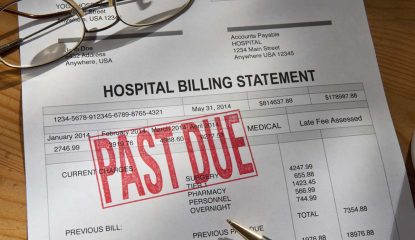NY Woman With Cancer Appeals Insurance Denial
By Consumers For Quality Care, on April 23, 2019

When the pain in Diane Conine’s stomach was so unbearable that she was throwing up and her urine was filled with blood, her daughter drove her to the emergency room. She had already been to an urgent care center, where she was told she had a bladder infection, according to the Albany Herald. Conine spent the drive to Piedmont Newnan Hospital vomiting into a trashcan in her lap. At the ER, physicians order a CT scan. The scan showed a five-centimeter tumor on her kidney. Conine had surgery not long after her diagnosis.
“I was just devastated,” Conine said. Three years before, her husband of 31 years, Bill, had died of a rare cancer, osteosarcoma of the spine.
Cancer wasn’t the only battle Conine was facing, however. She was insured with a plan from Anthem Blue Cross and Blue Shield, which she purchased on New York’s marketplace. When she signed up for the plan, it showed that WellStar Health System was in-network for the plan. But, what Conine and many other consumers did not realize, the provider network was only in-network through February.
“It’s more rural out here, and you have to have a plan with a hospital in Newnan in it,’’ Conine said. Nearby doctors are also listed as taking Anthem, she adds.
Anthem told Conine her care at Piedmont Newnan – from her emergency room to surgery to doctors’ fees – were out-of-network. In the denial-of-coverage letter, Anthem suggested that Conine should have been transferred to an in-network hospital. In all, she owed the hospital and physicians $87,000.
Disputing Anthem’s decision, Conine’s physician Dr. Roger Chen said that she was not in shape to be transferred. He said he made the decision to move forward with the surgery.
When Conine was brought in, she was bleeding internally from the mass, and the blood was going into the drainage system of the kidney, Chen said. She was also in great pain, he said. He determined surgery to be medically necessary.
Conine says that at one point, between when she entered the ER and awaited surgery and while she was heavily medicated, someone came in and told her that the hospital did not accept her insurance. Still, the surgery went forward. It achieved the three things it sought to: removing the mass, reducing the pain, and stopping the bleeding.
The bills started arriving a month after her surgery. Conine describes the panic she felt when she opened the bills and did not know how she was going to pay. Retired and on Social Security, she wondered if she would lose her house.
Conine’s patient advocate Cindi Gatton, says that she has seen other consumers facing the same issue. They go to a hospital believing it is in-network, only to later find out that it is not.
“They have significant financial problems to go with significant medical problems,” she said.
Conine, with the help of Gatton and the support of Dr. Chen, is appealing Anthem’s decision. In the meantime, she is being treated at in-network Tanner Medical Center, roughly 45 minutes away. While she is at a high risk of recurrence, she is currently cancer free. She is feeling better, but she still worries that if she has another emergency she will have nowhere to go.




